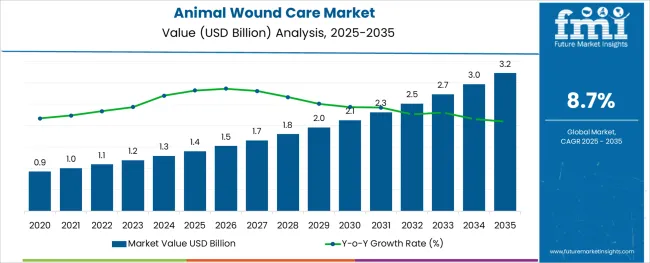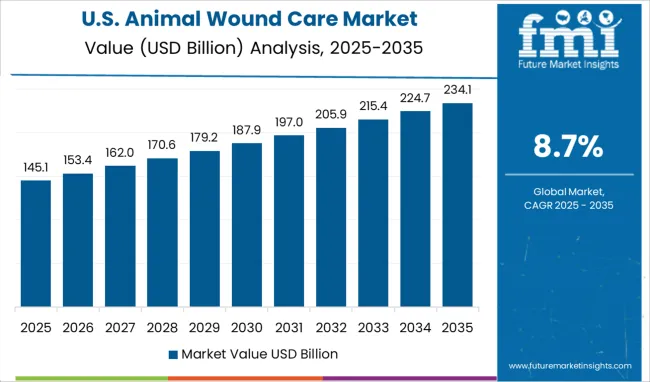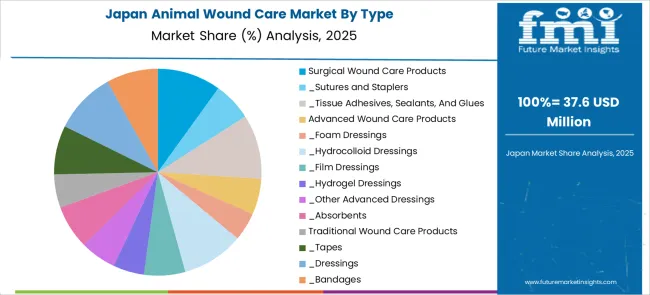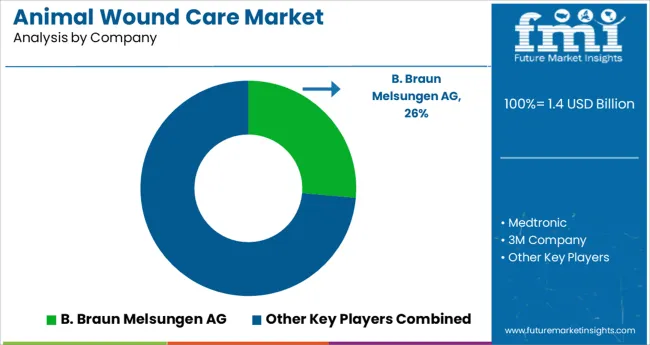The Animal Wound Care Market is estimated to be valued at USD 1.4 billion in 2025 and is projected to reach USD 3.2 billion by 2035, registering a compound annual growth rate (CAGR) of 8.7% over the forecast period.

The alginic acid market is undergoing consistent growth, propelled by rising demand from food processing, pharmaceutical formulations, and cosmetic applications. A growing focus on natural and sustainable ingredients in manufacturing processes has positioned alginic acid as a preferred biopolymer across industries.
The market is further supported by its diverse functional benefits, including water retention, gelling, and stabilizing properties, which make it indispensable in high-performance formulations. Increased regulatory acceptance of alginates as safe additives and the push towards cleaner labeling in food and personal care products have reinforced their adoption.
Ongoing innovation in extraction technologies and the utilization of algae as a renewable resource are paving the way for cost-effective production and expanded applications, ensuring sustained market expansion in the coming years.
The market is segmented by Type, Animal Type, End-user, and Distribution Channel and region. By Type, the market is divided into Surgical Wound Care Products, Advanced Wound Care Products, Traditional Wound Care Products, and Therapy Devices. In terms of Animal Type, the market is classified into Companion Animal and Livestock animal. Based on End-user, the market is segmented into Veterinary hospitals & clinics, Homecare, and Research Institutes.
By Distribution Channel, the market is divided into Retail, E-commerce, and Veterinary hospitals & clinics. Regionally, the market is classified into North America, Latin America, Western Europe, Eastern Europe, Balkan & Baltic Countries, Russia & Belarus, Central Asia, East Asia, South Asia & Pacific, and the Middle East & Africa.
The market is segmented by Type, Animal Type, End-user, and Distribution Channel and region. By Type, the market is divided into Surgical Wound Care Products, Advanced Wound Care Products, Traditional Wound Care Products, and Therapy Devices. In terms of Animal Type, the market is classified into Companion Animal and Livestock animal. Based on End-user, the market is segmented into Veterinary hospitals & clinics, Homecare, and Research Institutes.
By Distribution Channel, the market is divided into Retail, E-commerce, and Veterinary hospitals & clinics. Regionally, the market is classified into North America, Latin America, Western Europe, Eastern Europe, Balkan & Baltic Countries, Russia & Belarus, Central Asia, East Asia, South Asia & Pacific, and the Middle East & Africa.
When segmented by salts, sodium alginate is expected to command 27.5% of the market revenue in 2025, marking it as the leading subsegment in this category. This leadership has been driven by its superior solubility, ease of incorporation into formulations, and versatility in a wide range of applications.
Its ability to form stable gels and maintain viscosity under varying conditions has made it highly sought after in both food and pharmaceutical sectors. Manufacturers have prioritized sodium alginate due to its consistent performance, cost-effectiveness, and regulatory acceptance, which have collectively strengthened its position.
The segment’s prominence has also been enhanced by its adaptability to evolving consumer preferences for plant-derived and sustainable ingredients, reinforcing its market share.
Segmented by end user industry, the food industry is projected to hold 33.0% of the market revenue in 2025, positioning it as the most prominent sector. This dominance has been shaped by the industry’s increasing reliance on alginic acid and its derivatives to deliver desirable textures, stabilize emulsions, and improve shelf life of processed foods.
As consumer demand for clean label and natural additives has intensified, the food sector has responded by integrating alginates into bakery, dairy, and confectionery products. Enhanced production efficiency and compliance with food safety standards have further encouraged widespread use.
The segment’s leadership has also been supported by product differentiation strategies where alginates contribute to premium quality and innovation, securing their role in modern food formulations.
When analyzed by functionality, thickening agents are forecast to account for 29.0% of the market revenue in 2025, establishing themselves as the dominant functional category. This preeminence has been underpinned by the growing need for consistent texture and viscosity in a wide array of end products.
Alginic acid’s natural origin and high efficiency in creating uniform, stable thickness without altering taste or color have solidified its appeal. The demand for thickeners in both edible and topical applications has expanded, with manufacturers leveraging its rheological properties to meet performance and regulatory requirements.
The functionality’s leading share has also been reinforced by the ability to deliver cost savings through lower dosages and its compatibility with other ingredients, securing its position as an indispensable component in formulation strategies.
As per the Animal Wound Care Market research by Future Market Insights - a market research and competitive intelligence provider, historically, from 2020 to 2024, the market value of the market increased at around 7.3% CAGR.
The key factors driving the market of the animal wound care market are increased government and animal welfare association initiatives, as well as enhanced animal adoption and animal healthcare spending. Also, businesses are creating new companion animal products, which are anticipated to boost the market. For example, PetCare created a combo kit offering for pet health in March 2024. For pet health and wellness, this package contains Conditioning Tea Tree Oil Shampoo, Hot Spot Relief cream, and Skin and Coat Health Chews.
The demand for effective and early wound care products is expected to rise during the forecast period due to the high prevalence of diseases that cause wounds in animals. Increasing authorization and product launches of new animal wound care products are expected to be prominent drivers for the animal wound care market.
The market is being propelled by the increased adoption of companion animals and rising demand for veterinary surgeries. Furthermore, the rising number of veterinary visits is fuelling market expansion. The market is expanding due to the rising consumption of animal protein and advancements in wound care products.
North America held the largest animal wound care market, accounting for 32% of the global market in 2024. The increased efforts made by key players to promote their product portfolio and ensure standards are anticipated to fuel the regional market for wound care products. Elanco Animal Health will launch a new flea-preventative ointment in June 2024 to expand its product portfolio.
The demand for animal wound care in the Asia Pacific is expected to grow rapidly over the projected timeline. Since most nations rely on agricultural producers and exporters, the availability of domesticated animals is widespread and expected to grow significantly.
Furthermore, raising awareness about livestock diseases fuels regional market growth. High disposable income increases the likelihood of growing adoption of domestic pets, which broadens future growth prospects. Furthermore, it is expected that regular updates to healthcare infrastructure will provide the marketplace with potential growth opportunities over the forthcoming years.
The United States is expected to account for the largest market share of USD 3.2 million by the end of 2035. According to the Animal Cancer Foundation, canine and cat cancer is widespread in the United States, and the number is expected to grow by approximately six million cases annually. The country houses more than 65 million dogs and 35 million cats.

Furthermore, stringent government regulation pertaining to pet well-being is propelling revenue. For example, it is illegal under Canadian law to wilfully overlook, wound, injure, or maim an animal. Laws governing the treatment and care of farm animals are also in place in provinces and territories, which aids growth. European federal legislation has mandated the use of post-operative care in animals.
There were nearly 1.3 million dogs, 12 million cats, 1.6 million indoor birds, and 1.4 million domestic fowl in the United Kingdom in 2024. Owing to these figures, the market for animal wound care in the country is projected to reach a valuation of USD 1.33.5 million by 2035. The market in the country is expected to garner an absolute dollar opportunity of USD 1.4 million from 2025 to 2035.

Pet fondness in Japan can be estimated from the fact that it is the only country globally where pets outnumber children. According to the Japan Pet Food Association, the country is populated with 17 million children under 16 years of age, whereas it constitutes nearly 20 million cats and dogs. With these statistics, the market for animal wound care in Japan is expected to reach a valuation of USD 147 million by 2035, growing at a CAGR of 10.9% from 2025 to 2035.
The Surgical Wound Care Products is expected to account for the highest CAGR of 10.4% by the end of 2035. Sutures, staplers, and tissue adhesives are examples of surgical wound care products. Skin staplers have grown in popularity due to benefits such as ease of use, reduced surgical procedure time, and ease of removal. Depending on the application, absorbable or non-absorbable sutures can be used. Surgeries sutures and suture cassettes are used to provide temporary assistance for wound healing in a variety of veterinary surgeries, including orthopedic, cardiovascular, and neurological procedures.
In 2024, the market through companion animals held the largest market for animal wound care, with a revenue share of more than 64%. The segment captured the lion's share as pet healthcare spending increased, particularly in developed regions. One of the key growth drivers for animal wound care is the growing demand for non-invasive surgeries. Modern surgeries have numerous advantages, such as relatively small surgical wounds and fewer stitches, giving pet parents confidence to choose advanced minimally invasive surgical operations.

To gain a competitive advantage in the animal wound care market, key players are planning to invest in strategies such as growth plans, product launches, mergers, and partnerships. Some of the key players operating in the market include Elanco Animal Health, Medtronic PLC, B. Braun Melsungen AG, Virbac, Jorgen Kruuse A/S, Dechra Pharmaceuticals, Neogen Corporation, Ethicon, Inc., Sonoma Pharmaceuticals Inc., Jazz Medical LLC, and Prima-Vet Inc.
Some of the recent developments in the Animal Wound Care Market are:
The active ingredients of the product include an insect growth regulator (IGR), an adulticide, and a synergist that provides protection from infestations, kills louse eggs before hatching, and results in season-long lice control in one application.
Elanco will collaborate with Purdue's life science researchers, who specialize in animal science, systems biology, protein evolution, and engineering, microbiome discovery, and clinical veterinary medicine. As part of the agreement, Elanco and Purdue's Life Sciences would therefore work on a broad array of research projects in Purdue's laboratories.
Similarly, more recent developments related to companies in Animal Wound Care Market services have been tracked by the team at Future Market Insights, which are available in the full report.
The global animal wound care market is estimated to be valued at USD 1.4 billion in 2025.
It is projected to reach USD 3.2 billion by 2035.
The market is expected to grow at a 8.7% CAGR between 2025 and 2035.
The key product types are surgical wound care products, _sutures and staplers, _tissue adhesives, sealants, and glues, advanced wound care products, _foam dressings, _hydrocolloid dressings, _film dressings, _hydrogel dressings, _other advanced dressings, _absorbents, traditional wound care products, _tapes, _dressings, _bandages, _absorbents, _other traditional wound care products and therapy devices.
companion animal segment is expected to dominate with a 58.2% industry share in 2025.






Full Research Suite comprises of:
Market outlook & trends analysis
Interviews & case studies
Strategic recommendations
Vendor profiles & capabilities analysis
5-year forecasts
8 regions and 60+ country-level data splits
Market segment data splits
12 months of continuous data updates
DELIVERED AS:
PDF EXCEL ONLINE
Animal External Fixation Market Size and Share Forecast Outlook 2025 to 2035
Animal Antibiotics and Antimicrobials Market Size and Share Forecast Outlook 2025 to 2035
Animal Auto-Immune Disease Diagnostics Market Size and Share Forecast Outlook 2025 to 2035
Animal Disinfectants Market Size and Share Forecast Outlook 2025 to 2035
Animal Health Software Market Size and Share Forecast Outlook 2025 to 2035
Animal Antimicrobials and Antibiotics Market Size and Share Forecast Outlook 2025 to 2035
Animal Sedative Market Size and Share Forecast Outlook 2025 to 2035
Animal Genetics Market Size and Share Forecast Outlook 2025 to 2035
Animal Peptides Market Size and Share Forecast Outlook 2025 to 2035
Animal Immunoassay Kits Market Analysis - Size, Share, and Forecast Outlook 2025 to 2035
Animal Gastroesophageal Reflux Disease Market Size and Share Forecast Outlook 2025 to 2035
Animal Parasiticide Market Size and Share Forecast Outlook 2025 to 2035
Animal Model Market Analysis - Size, Share, and Forecast Outlook 2025 to 2035
Animal Feed Additives Market Analysis - Size, Share, & Forecast Outlook 2025 to 2035
Animal Feed Organic Trace Minerals Market Size and Share Forecast Outlook 2025 to 2035
Animal Nutrition Chemicals Market Analysis - Size, Share, and Forecast Outlook 2025 to 2035
Animal Artificial Insemination Market Report - Trends, Demand & Industry Forecast 2025 to 2035
Animal Parasiticides Market Size and Share Forecast Outlook 2025 to 2035
Animal Feeds Microalgae Market Size and Share Forecast Outlook 2025 to 2035
Animal Feed Probiotic Market Analysis - Size, Share, and Forecast Outlook 2025 to 2035

Thank you!
You will receive an email from our Business Development Manager. Please be sure to check your SPAM/JUNK folder too.
Chat With
MaRIA